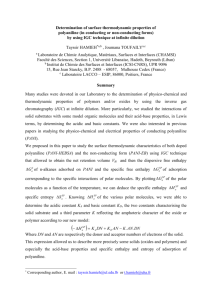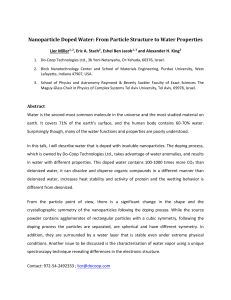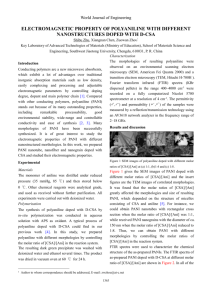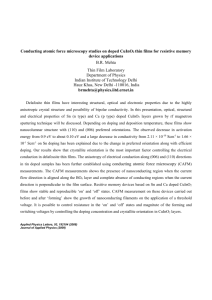Complexation of polyaniline with Lewis acids − a Mössbauer
advertisement
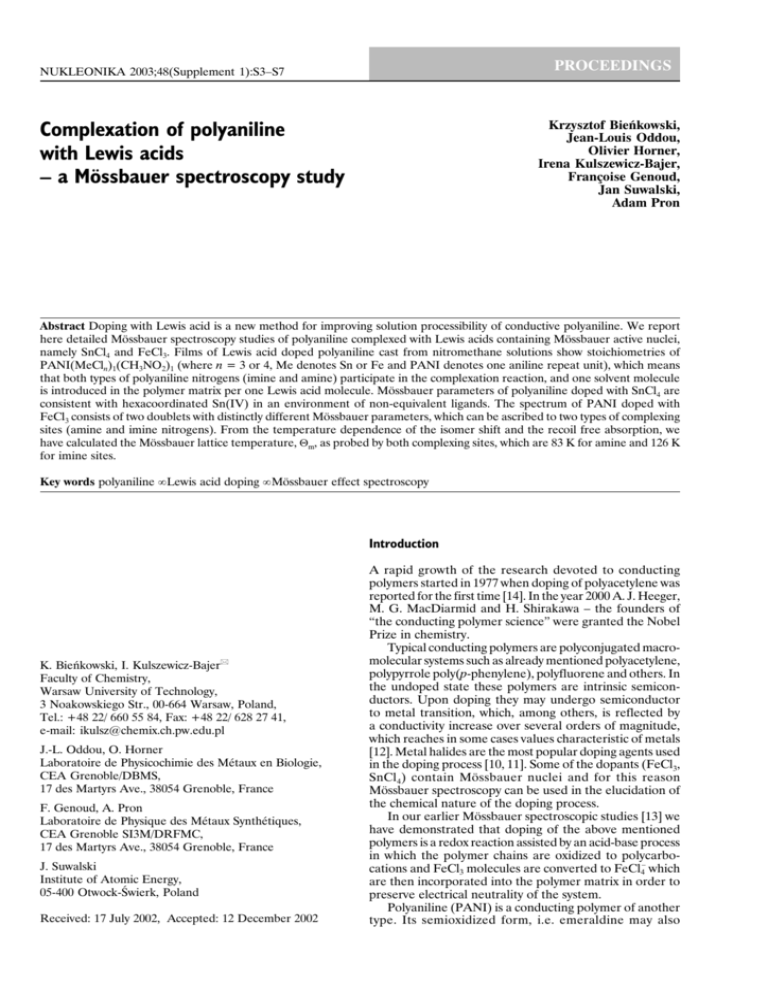
PROCEEDINGS NUKLEONIKA 2003;48(Supplement 1):S3−S7 Krzysztof Bieńkowski, Jean-Louis Oddou, Olivier Horner, Irena Kulszewicz-Bajer, Françoise Genoud, Jan Suwalski, Adam Pron Complexation of polyaniline with Lewis acids − a Mössbauer spectroscopy study Abstract Doping with Lewis acid is a new method for improving solution processibility of conductive polyaniline. We report here detailed Mössbauer spectroscopy studies of polyaniline complexed with Lewis acids containing Mössbauer active nuclei, namely SnCl4 and FeCl3. Films of Lewis acid doped polyaniline cast from nitromethane solutions show stoichiometries of PANI(MeCln)1(CH3NO2)1 (where n = 3 or 4, Me denotes Sn or Fe and PANI denotes one aniline repeat unit), which means that both types of polyaniline nitrogens (imine and amine) participate in the complexation reaction, and one solvent molecule is introduced in the polymer matrix per one Lewis acid molecule. Mössbauer parameters of polyaniline doped with SnCl4 are consistent with hexacoordinated Sn(IV) in an environment of non-equivalent ligands. The spectrum of PANI doped with FeCl3 consists of two doublets with distinctly different Mössbauer parameters, which can be ascribed to two types of complexing sites (amine and imine nitrogens). From the temperature dependence of the isomer shift and the recoil free absorption, we have calculated the Mössbauer lattice temperature, Θm, as probed by both complexing sites, which are 83 K for amine and 126 K for imine sites. Key words polyaniline • Lewis acid doping • Mössbauer effect spectroscopy Introduction K. Bieńkowski, I. Kulszewicz-Bajer Faculty of Chemistry, Warsaw University of Technology, 3 Noakowskiego Str., 00-664 Warsaw, Poland, Tel.: +48 22/ 660 55 84, Fax: +48 22/ 628 27 41, e-mail: ikulsz@chemix.ch.pw.edu.pl J.-L. Oddou, O. Horner Laboratoire de Physicochimie des Métaux en Biologie, CEA Grenoble/DBMS, 17 des Martyrs Ave., 38054 Grenoble, France F. Genoud, A. Pron Laboratoire de Physique des Métaux Synthétiques, CEA Grenoble SI3M/DRFMC, 17 des Martyrs Ave., 38054 Grenoble, France J. Suwalski Institute of Atomic Energy, 05-400 Otwock-Świerk, Poland Received: 17 July 2002, Accepted: 12 December 2002 A rapid growth of the research devoted to conducting polymers started in 1977 when doping of polyacetylene was reported for the first time [14]. In the year 2000 A. J. Heeger, M. G. MacDiarmid and H. Shirakawa – the founders of “the conducting polymer science” were granted the Nobel Prize in chemistry. Typical conducting polymers are polyconjugated macromolecular systems such as already mentioned polyacetylene, polypyrrole poly(p-phenylene), polyfluorene and others. In the undoped state these polymers are intrinsic semiconductors. Upon doping they may undergo semiconductor to metal transition, which, among others, is reflected by a conductivity increase over several orders of magnitude, which reaches in some cases values characteristic of metals [12]. Metal halides are the most popular doping agents used in the doping process [10, 11]. Some of the dopants (FeCl3, SnCl 4) contain Mössbauer nuclei and for this reason Mössbauer spectroscopy can be used in the elucidation of the chemical nature of the doping process. In our earlier Mössbauer spectroscopic studies [13] we have demonstrated that doping of the above mentioned polymers is a redox reaction assisted by an acid-base process in which the polymer chains are oxidized to polycarbocations and FeCl3 molecules are converted to FeCl4− which are then incorporated into the polymer matrix in order to preserve electrical neutrality of the system. Polyaniline (PANI) is a conducting polymer of another type. Its semioxidized form, i.e. emeraldine may also K. Bieńkowski et al. S4 become conductive. However, in this case the doping is an acid-base reaction in the Brönsted sense and consists of the protonation of the base form of emeraldine with a sufficienty strong protonic acid i.e. Brönsted acid. PANI belongs to the most intensively studied conducting polymers because it shows good environmental stability and processibility in the conducting form. Conducting and processible PANI can be obtained by doping with functionalized protonic acids [2]. Such acids should be sufficiently strong for polymer protonation and possess functional groups inducting the solubilization of polyaniline stiff chains. Due to the presence of the lone electron pair on the imine and amine sites, emeraldine is not only a Brönsted base, but also a Lewis base. Recently, we have demonstrated that polyaniline can be doped not only with Brönsted acids, but also with Lewis acids i.e. molecules with electron deficit capable of formation of a coordination bond with emeraldine via its lone pair of electrons. Several Lewis acids have been tested as polyaniline dopants, for example, BF3 [3], AlCl3, SnCl4 and FeCl3 [4, 7]. It should be noted here that the latter dopants (FeCl3, SnCl4) which act as oxidants in the case of other than polyaniline conductive polymers, in the latter case act as complexing agents of Lewis acid nature – they are too weak oxidizing agents to be involved in a redox reaction with the semi-oxidized form of polyaniline. Lewis acid type doping is extremely important since the complexation of polyaniline with halide type Lewis acids significantly alters the band structure of the polymer and leads to important changes in its electrical properties. Moreover, Lewis acid complexation improves the processibility of PANI, which becomes soluble in the doping medium. The spectroscopic properties of Lewis acid doped polyaniline are significantly different from those of Brönsted acid doped polymer due to the different types of chemical interactions in both systems. The main purpose of this research was to study dopant-polymer interactions in Lewis acid doped polyaniline using Mössbauer effect spectroscopy. Our investigations were complemented by elemental analyses. Experimental Polyaniline was synthesized according to the method described in [1]. The obtained emeraldine hydrochloride was then converted to the base form by treatment with a 0.3 M NH3(aq.) solution and dried to constant mass under dynamic vacuum. Emeraldine base was doped with Lewis acid (FeCl3 or SnCl4) in nitromethane solutions using classical high-vacuum techniques. The doping was carried out for ca. 15 h. Lewis acid-base complexation renders polyaniline soluble in nitromethane as shown by a deep blue coloration of the doping medium. Free-standing films of doped polymer were obtained by evaporation of the solvent in vacuum. In addition to the doping of emeraldine base, we have performed in the same manner the complexation of emeraldine hydrochloride with Lewis acids. These experiments were carried out with the goal to develop a new doping procedure so called the “mixed Brönsted-Lewis acid doping”. Mössbauer spectra were recorded for free-standing films of polyaniline. Fig. 1. Brönsted acid doping of emeraldine. Results and discussion Polyaniline in the oxidation state of emeraldine possesses two types of basic sites, i.e. amine and imine nitrogens. In the polymer chain they are present in equal numbers (Fig. 1). The doping of emeraldine base with Brönsted acids causes the protonation of imine groups whereas the amines groups do not participate in this reaction. Spectroscopic studies as well as theoretical calculations show that in this type of acid-base reaction a polysemiquinone radical structure is formed, which is the most stable resonant form of protonated polyaniline [8]. However, the chemical interactions of polyaniline with Lewis acids such as SnCl4 and FeCl3 should be different from those occurring between PANI and a Brönsted acid due to different type of chemical bonds created upon the doping process. Elemental analyses of emeraldine base doped with Lewis acids (C, H, N by combustion, Cl by combustion and mercuriometric titration, Fe by colorimetry) show that the maximum content of Lewis molecules which can be inserted into the polymer matrix is one dopant molecule per repeat unit of emeraldine, i.e. one phenylene ring and one nitrogen atom. Thus, this means that in the case of the acid-base reaction of this type, each nitrogen atom (amine as well as imine) can be coordinated with a Lewis acid molecule. Elemental analyses (Table 1) also show that the amount of nitrogen is roughly twice higher than that expected for a simple coordination of emeraldine with a metal halide. In the simplest interpretation the excess amount of nitrogen is related with nitromethane entered the polymer matrix. Thus, each Lewis acid molecule complexing basic sites of PANI is solvated with one nitromethane molecule. This is schematically depicted in Fig. 2. This scheme corresponds to the formula: (1) (C6H4.5N)(MeXn)1.0(NM)1.0 Fig. 2. Lewis acid doping of emeraldine. Complexation of polyaniline with Lewis acids − a Mössbauer spectroscopy study Sample S5 %C %H %N %Cl %M calculated for PANI/(SnCl4)1.0/(NM)1.0 found 20.36 19.74 1.82 1.89 6.79 5.67 34.42 34.02 28.85 29.20 calculated for PANI/(HCl)0.45(SnCl4)0.55/(NM)0.55 found 27.67 25.48 2.34 2.59 7.64 6.55 33.12 33.15 23.04 20.90 calculated for PANI/(FeCl3)0.96/(NM)0.96 found 27.38 27.81 2.42 2.51 8.99 8.78 33.51 31.73 17.62 17.99 calculated for PANI/(FeCl3)0.87/(NM)0.87 found 28.97 28.89 2.50 2.48 9.20 8.51 32.56 31.36 17.12 17.19 calculated for PANI/(HCl)0.45(FeCl3)0.43/(NM)0.38 found 38.42 40.18 3.06 3.13 9.69 9.22 30.65 30.60 12.08 12.21 As already mentioned, we have also performed a mixed – type Brönsted acid-Lewis acid doping. In this case, the PANI base is first doped to saturation with HCl (a Brönsted acid). Such doping results in the protonation of the imine sites, which constitute 50% of nitrogen atoms in the polymer. Then, a Lewis acid complexation is carried out on the remaining nitrogen sites, which retain their Lewis base character. From elemental analyses presented in Table 1, it is clear that in this case Lewis acid doping is complementary to the Brönsted one. The 119Sn Mössbauer spectrum of PANI (SnCl4)1.0(NM)1.0, recorded at 78 K, is presented in Fig. 3. whereas the calculated Mössbauer parameters are listed in Table 2. The isomer shift (IS) of tin in tetracoordinated uncomplexed SnCl4 is 0.84 mm/s relative to SnO2 [6]. The decrease of this parameter to 0.43 mm/s upon insertion of the dopant into the polymer matrix suggests a change in the coordination sphere of tin. In fact, the observed value is close to those reported for SnCl4 complexes with bidentate basic ligands such as pyridine, bipyridine and others [9]. The Mössbauer parameters are, therefore, consistent with 6-fold coordination of tin in the polyaniline matrix, which must involve complexation with one molecule of nitromethane. Thus, Mössbauer spectroscopy study strongly supports the results of the elemental analysis. Isomer shift values of SnCl4 in purely Lewis acid doped PANI and in the mixed one (Brönsted acid−Lewis acid doped PANI) are slightly different (0.43 and 0.49 mm/s, respectively). This may be caused by a small alteration of electron density on the complexing nitrogen atom via the protonated nitrogen atom, which is adjacent to it. The observed quadrupole splitting (QS) values in both types of SnCl4 complexes studied are the same (0.49 mm/s) and reflect chemical nonequivalency of the ligands of tin coordinated by the tin chloride (chlorine, polymer chain via nitrogen atom and nitromethane molecule). In the case of the SnCl4 doped samples, the quadrupole interactions are not resolved and only contribute to the broadening and shape of the spectral lines. On the contrary, Table 1. Elemental analyses of emeraldine/emeraldine hydrochloride doped in SnCl4/nitromethane and FeCl3/nitromethane solutions. in the case of PANI base doped with FeCl 3 , i.e. PANI (FeCl3)0.87(NM)0.87 (Fig. 4) the spectrum measured at 78 K can be deconvoluted into two doublets corresponding to two non-equivalent complexing sites in the polymer matrix, i.e. the amine and imine nitrogens. Their Mössbauer parameters are listed in Table 3. The internal doublet (lower QS) value corresponds to the complexation on the amine nitrogens and the external one to the complexation on the imine ones. This conclusion is drawn on the basis of comparison of the Mössbauer spectra of purely Lewis acid and mixed (Brönsted acid and Lewis acid) doped PANI i.e. PANI (FeCl 3 ) 0.87 (NM) 0.87 and PANI(HCl)0.45(FeCl3)0.43(NM)0.38. In the latter case the imine sites are not available for Lewis acid complexation 119 Sn Mössbauer parameters at 78 K of emeraldine and emeraldine hydrochloride doped with SnCl4. Isomer shift values are relative to SnO2 at 300 K. Table 2. Sample PANI/(SnCl4)1.0/(NM)1.0 IS QS (mm/s) (mm/s) one site 0.43(2) 0.49(2) PANI/(HCl)0.45(SnCl4)0.55/(NM)0.55 one site 0.49(2) 0.49(2) Fig. 3. 119Sn Mössbauer spectra, recorded at 78 K, of emeraldine (a) and emeraldine hydrochloride (b) doped with SnCl4. K. Bieńkowski et al. S6 Table 3. 57Fe Mössbauer parameters at 78 K of emeraldine and emeraldine hydrochloride doped with FeCl3. Isomer shift values are relative to α-Fe at 300 K. IS (mm/s) QS (mm/s) Θm (K) external doublet internal doublet 0.48(1) 0.32(1) 0.89(2) 0.38(1) 126(5) 86(5) one site 0.31(1) 0.38(1) 79(5) Sample PANI/(FeCl3)0.87/(NM)0.87 PANI/(HCl)0.45(FeCl3)0.43/(NM)0.38 because they are blocked by protonation. As a result, the external doublet does not appear in the spectrum, which can be fitted with only one doublet with Mössbauer parameters identical to those calculated for the internal doublet of purely Lewis acid doped PANI. In the Mössbauer spectrum of PANI base complexed with FeCl 3, in addition to the two principal doublets ascribed to Fe(III) an additional doublet of small intensity, characteristic of Fe(II), is present. The latter is due to incomplete removal of water from the system which catalyses the redox reaction between the dopant and the polymer chain even if present in minute amounts. Despite several attempts we were unable to remove completely these minute amounts of water. The intensity of the registered Mössbauer spectra is strongly temperature dependent. At temperatures approaching RT the absorption is very small indicating a significant mobility of the dopant inserted into the polymer matrix. The recoil free fraction is related to the Debye temperature of the system Θ and, more precisely, to the Mössbauer lattice temperature, Θm, which is the lattice temperature as probed by the iron atom at a particular site. To calculate Θm we have followed the procedure described in detail in [5]. In particular, using the temperature dependence of the isomer shift and the normalized absorption and within the high-temperature limit of the Debye model we have calculated Θm values for both complexing sites (amine and imine nitrogens): 1/ 2 (2) dIS / dT Θ m = 432.03 ⋅ d ln A / dT where T > Θm 2 Since the temperature of the measurement must be lower than Θm/2, the spectra have been registered in the temperature range 78–280 K. The Θm values (see Table 3) are very low and indicate a significant mobility of the dopant close to room temperature and even at lower temperature. One should note that Θm determined for the dopant complexed at the imine sites is higher than that obtained for the dopant complexed at the amine sites. This is not unexpected taking into account significantly higher stiffness of the imine-quinoid segments of the polymer chain as compared to the amine-benzoid ones. At the end it should be noted that PANI doped with Lewis acids is less conductive than PANI doped by protonation. Typical conductivity usually does not exceed 10−1−10−2 S/cm. Mixed doping leads to higher conductivities, usually of few S/cm. Conclusions To summarize, we have demonstrated that Mössbauer spectroscopy is a suitable method for characterization of polyaniline complexed with Lewis acids. In particular, the Mössbauer effect data strongly indicate that the inserted dopant is complexed not only by the polymer chain but also by solvent molecules in agreement with the elemental analysis data. Two non-equivalent complexing sites can be identified by the 57Fe Mössbauer effect, namely the imine and amine sites consistent with the postulated chemical formula of polyaniline. The latter show a higher Mössbauer lattice temperature, Θm, probably due to the higher stiffness of the dopant-imine nitrogen association as compared to the dopant-amine nitrogen one. References 57 Fe Mössbauer spectra, recorded at 78 K of emeraldine (a) and emeraldine hydrochloride (b) doped with FeCl3. Fig. 4. 1. Beadle PM, Nicolau YF, Banka E, Rannou P, Djurado D (1998) Controlled polymerization of aniline at sub-zero temperatures. Synth Met 95:29−45 Complexation of polyaniline with Lewis acids − a Mössbauer spectroscopy study 2. Cao Y, Smith P, Heeger AJ (1992) Counter-ion inducted processibility of conducting polyaniline and of conducting polyblends of polyaniline in bulk polymers. Synth Met 48:91−97 3. Chaudhuri D, Kumar A, Rudra I, Sarma DD (2001) Synthesis and spectroscopic characterization of highly conducting BF3 − doped polyaniline. Adv Mater 13:1548−1551 4. Genoud F, Kulszewicz-Bajer I, Bedel A, Jeandey C, Oddou J-L, Pron A (2000) Lewis acid doped polyaniline. Part II: Spectroscopic studies of emeraldine base and emeraldine hydrochloride complexation with FeCl 3 . Chem Mater 12:744−749 5. Herber RH, Maeda Y (1980) Lattice dynamics and hyperfine interactions of layer compounds from 57Fe Mössbauer spectroscopy: FeOCl. Physica B 99:352−356 6. Ichiba S, Katada M, Negita H (1972) Mössbauer effect of 119 Sn in tetracarbonylcobalt derivatives of tin(IV) halides. Bull Chem Soc Jpn 45:1679−1682 7. Kulszewicz-Bajer I, Pron A, Abramowicz J, Jeandey C, Oddou J-L, Sobczak JW (1999) Lewis acid doped polyaniline: preparation and spectroscopic characterization. Chem Mater 11:552−556 S7 8. MacDiarmid AG, Chiang JC, Richter AF, Epstein AJ (1987) Polyaniline: a new concept in conducting polymers. Synth Met 18:285−290 9. Philip J, Mullins MA, Curran C (1968) Moessbauer spectra of some complexes of tin(IV) chloride and tin(IV) bromide with organic ligands. Inorg Chem 7:1895−1898 10. Pron A, Kulszewicz I, Billaud D, Przyłuski J (1981) Organic metals. Reaction of FeCl3 with polyacetylene and poly-pphenylene. J Chem Soc, Chem Commun 15:783−784 11. Pron A, Kulszewicz I, Przyłuski J, Billaud D (1983) Oxidation of polyacetylene with tin tetrachloride. Polymer Commun 24:57−59 12. Pron A, Rannou P (2002) Processible conjugated polymers: from organic semiconductors to organic metals and superconductors. Prog Polym Sci 27:135−190 13. Pron A, Zagórska M, Kucharski Z, Łukasiak M, Suwalski J (1982) Mössbauer spectroscopy studies of polyacetylene doped with iron chloride complexes. Mater Res Bull 17:1505−1510 14. Shirakawa H, Louis EJ, MacDiarmid AG, Chiang CK, Heeger AJ (1977) Synthesis of electrically conducting organic polymers: halogen derivatives of poly(acetylene), (CH)x. J Chem Soc, Chem Commun 16:578−579
